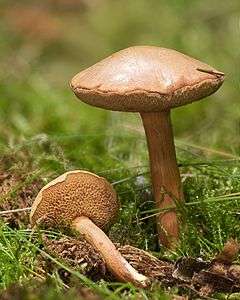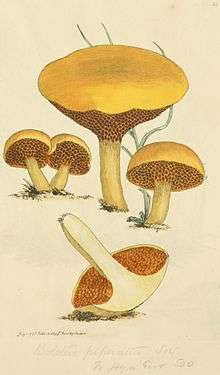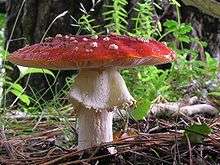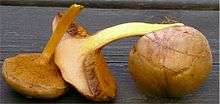Chalciporus piperatus
Chalciporus piperatus, commonly known as the peppery bolete, is a small pored mushroom of the family Boletaceae found in mixed woodland in Europe and North America. It has been recorded under introduced trees in Brazil, and has become naturalised in Tasmania and spread under native Nothofagus cunninghamii trees. A small bolete, the fruit body has a 1.6–9 cm (0.6–3.5 in) orange-fawn cap with cinnamon to brown pores underneath, and a 4–9.5 cm (1.6–3.7 in) high by 0.6–1.2 cm (0.2–0.5 in) thick stipe. The rare variety hypochryseus, found only in Europe, has yellow pores and tubes.
| Chalciporus piperatus | |
|---|---|
 | |
| Scientific classification | |
| Kingdom: | |
| Division: | |
| Class: | |
| Order: | |
| Family: | |
| Genus: | |
| Species: | C. piperatus |
| Binomial name | |
| Chalciporus piperatus | |
| Synonyms[1] | |
| Chalciporus piperatus | |
|---|---|
float | |
| pores on hymenium | |
| cap is convex | |
| hymenium is adnate | |
| stipe is bare | |
| spore print is brown | |
| edibility: edible, but unpalatable | |
Described by Pierre Bulliard in 1790 as Boletus piperatus, it is only distantly related to other members of the genus Boletus and was reclassified as Chalciporus piperatus by Frédéric Bataille in 1908. The genus Chalciporus was an early branching lineage in the Boletaceae and appears to be related to boletes with parasitic properties. Previously thought to be ectomycorrhizal (a symbiotic relationship that occurs between a fungus and the roots of various plant species), C. piperatus is now suspected of being parasitic on Amanita muscaria. The flesh of C. piperatus has a very peppery taste, and can be used as a condiment or flavouring.
Taxonomy and naming

French mycologist Pierre Bulliard described the species as Boletus piperatus in 1790.[2] In its taxonomic history, it has been transferred to the genera Leccinum (Samuel Frederick Gray, 1821), Viscipellis (Lucien Quélet, 1886), Ixocomus (Quélet, 1888), Suillus (Otto Kuntze, 1898), and Ceriomyces (William Alphonso Murrill, 1909).[1] It was reclassified and given its current binomial name in 1908 by Frédéric Bataille when he made it the type species of the newly circumscribed genus Chalciporus.[3] The species name piperatus means "peppery" in Latin.[4] It is commonly known as the "peppery bolete".[5]
Chalciporus piperatus is a member of the genus Chalciporus, with which the genus Buchwaldoboletus form a group of fungi that is an early offshoot in the Boletaceae. Many members of the group appear to be parasitic.[6]
Two varieties have been described. Chalciporus piperatus var. hypochryseus was originally described as Boletus hypochryseus by Czech mycologist Josef Šutara in 1993,[7] and was moved to Chalciporus a year later by Regis Courtecuisse.[8] Wolfgang Klofac and Irmgard Krisai-Greilhuber reclassified it as a variety of C. piperatus in 2006,[9] although some sources continue to regard it as a distinct species.[10] Variety amarellus, first published by Quélet as Boletus amarellus in 1883 and later transferred to Chalciporus by Bataille in 1908, was described as a variety of C. piperatus in 1974 by Albert Pilát and Aurel Dermek. Authorities disagree as to whether or not it has independent taxonomic significance.[11][12]
Description
One of the smaller boletes, Chalciporus piperatus has an orange-fawn 1.6–9 cm (0.6–3.5 in) cap that is initially convex before flattening out in age.[13] The cap surface can be furrowed;[14] shiny when dry,[4] it can be a little sticky when wet.[14] The colour of the pore surface ranges from cinnamon to dark reddish brown in maturity. When bruised, the pore surface stains brown. Individual pores are angular, measuring about 0.5–2 mm wide, while the tubes are 3–10 mm deep.[13] Slender for a bolete,[4] the stipe measures 4–9.5 cm (1.6–3.7 in) long by 0.6–1.2 cm (0.2–0.5 in) thick, and is either roughly the same width throughout its length, or slightly thicker near the base. The colour of the stem is similar to the cap, or lighter, and there is yellow mycelium at the base. The flesh is yellow, sometimes with reddish tones, maturing to purplish brown. It has no odour. The spore print is brown to cinnamon.[13] Variety hypochryseus is essentially identical to the main form except for its bright yellow tubes and pores.[7] Variety amarellus has pinker pores and a taste that is bitter rather than peppery.[15]
_Bataille_99106.jpg)
The spores are smooth, narrowly fusiform (fuse-shaped), and measure 7–12 by 3–5 µm. The basidia (spore-bearing cells) measure 20–28 by 6–8 µm and are hyaline (translucent), four-spored, and narrowly club-shaped, with many internal oil droplets. Cystidia are fusiform, sometimes with a rounded tip, and have dimensions of 30–50 by 9–12 µm. Some are more or less hyaline, while others are encrusted with a golden pigment.[16] The cap cuticle is a trichodermium, an arrangement in which the outermost hyphae emerge roughly parallel, like hairs, perpendicular to the cap surface. These hyphae are 10–17 µm wide and have elliptical to cylindrical cells at their ends that are not gelatinous. Clamp connections are absent from the hyphae.[17]
Similar species
The fruit body of the North American species Chalciporus piperatoides are similar, but can be distinguished by its flesh and pores staining blue after cutting or bruising. It has a less peppery taste.[18] Another mild-tasting relative, C. rubinellus, has brighter colours than C. piperatus, including completely red tubes.[19] One European species, C. rubinus, has a shape similar to C. piperatus, but has red pores and a stem covered in red dots.[15]
Distribution and habitat

Fruit bodies of Chalciporus piperatus occur singly, scattered, or in groups on the ground.[17] The fungus occurs naturally in or near coniferous or beech and oak woodlands, often on sandy soils.[20] Fruit bodies appear in Europe in late summer and autumn from August to November.[21] The fungus is widespread across North America, fruiting from July to October in the eastern states and from September to January on the Pacific Coast.[22] It is found in Mexico and Central America.[9] In Asia, it has been collected from Pakistan,[23] West Bengal (India),[24] and Guangdong Province (China).[25] In South Africa, it is known from the southwestern Cape Province and the eastern Transvaal Province.[26]
Chalciporus piperatus grows in conifer plantations associated with the fly agaric (Amanita muscaria) and the chanterelle (Cantharellus cibarius).[21] It has been recorded under introduced loblolly pine (Pinus taeda) plantations in Santa Catarina and Paraná states in southern Brazil,[27] and under introduced trees in the Los Lagos Region of Chile.[28] It has also spread into native forest in northeastern Tasmania and Victoria, having been found growing with the native myrtle beech (Nothofagus cunninghamii).[29][30] The rare variety hypochryseus occurs only in Europe, including Austria, the Czech Republic, Greece, Italy, and Spain.[10] Also rare, variety amarellus is widespread in European coniferous forests, where it usually found near pines, spruce, and sometimes fir.[9]
Fruit bodies can be parasitised by the mould Sepedonium chalcipori, a highly specialised mycoparasite that is only known to infect this bolete. Infections result in necrotic mushroom tissue and the production of copious yellow conidia.[31]
Initially thought to be ectomycorrhizal (symbiotic with plants, like most Boletaceae), C. piperatus has not been confirmed as such in multiple synthesis studies[32][33][34] or in isotope fractionation studies.[35][36][37] There is some speculation that C. piperatus is a mycoparasite on the mycorrhiza of Amanita muscaria.[15] In New Zealand, A. muscaria is thought to have been introduced with Pinus radiata, and has made a host jump to the native Nothofagus trees; C. piperatus has since been observed fruiting near Nothofagus trees with A. muscaria associations.[30][37] Buchwaldoboletus lignicola is in the same clade as C. piperatus and is thought to be a parasite as well, strengthening the evidence that C. piperatus and its relatives may be mycoparasites.[6]
Uses

This mushroom is edible but very peppery. The Italian chef Antonio Carluccio recommends only using it to add flavour to other mushrooms. It has been used as a condiment in many countries.[20] The mushroom should be well-cooked before consumption to minimize the risk of gastric symptoms;[22] the peppery taste is lost with cooking.[38] In powdered form, it loses its peppery taste quickly.[39] Some guidebooks classify C. piperatus as inedible.[4][15] Fruit bodies can be used for mushroom dyeing; depending on the mordant used, yellow, orange, or greenish-brown dyes can be made.[15]
Chemistry
Sclerocitrin, a pigment compound originally isolated from the common earthball (Scleroderma citrinum), is the major contributor to the yellow colour of the mycelium and the stipe base of C. piperatus fruit bodies. Other compounds that have been isolated from this species include norbadione A, chalciporone, xerocomic acid, variegatic acid, variegatorubin, and another yellow pigment, chalcitrin. Chalciporone is responsible for the bitter taste of the fruit bodies. The pigments sclerocitrin, chalcitrin, and norbadione A are derived biosynthetically from xerocomic acid.[40] Related compounds found in the fruit bodies include the chalciporone isomers isochalciporone and dehydroisochalciporone.[41]
A field study of fungi growing in polluted sites in the Czech and Slovak Republics found that C. piperatus fruit bodies growing near lead smelters and on mine and slag dumps had the greatest ability to bioaccumulate the element antimony. In one collection, an "extremely high" level of the element was detected—1423 milligrams of antimony per kilogram of dried mushroom. In comparison, the antimony levels detected in other common terrestrial fungi from the same area, both saprobic and ectomycorrhizal, were more than an order of magnitude smaller.[42]
See also
References
- "Chalciporus piperatus (Bull.) Bataille, Bulletin de la Société d'Histoire Naturelle du Doubs, 15: 39, 1908". MycoBank. International Mycological Association. Retrieved 14 May 2013.
- Bulliard F. (1790). Herbier de la France (in French). 10. Paris: Chez l'auteur, Didot, Debure, Belin. Pl. 451; fig. II.
- Bataille F. (1908). "Quelques champignons intéressants des environs de Besançon". Bulletin de la Société d'Histoire Naturelle du Doubs (in French). 15: 23–61 (see p. 39).
- Nilson S, Persson O (1977). Fungi of Northern Europe 1: Larger Fungi (Excluding Gill-Fungi). Harmondsworth: Penguin. pp. 106–07. ISBN 978-0-14-063005-3.
- "List of recommended English Names for Fungi in the UK" (PDF). British Mycological Society. 2003. Archived from the original (PDF) on 2011-07-16.
- Nuhn ME, Binder M, Taylor AF, Halling RE, Hibbett DS (2013). "Phylogenetic overview of the Boletineae". Fungal Biology. 117 (7–8): 479–511. doi:10.1016/j.funbio.2013.04.008. PMID 23931115.
- Šutara J. (1993). "Boletus hypochryseus, nový hřib ze skupiny druhu Boletus piperatus" [Boletus hypochryseus, new species, a new bolete from the Boletus piperatus group]. Česká Mykologie (in Czech). 46 (3–4): 203–08.
- Courtecuisse R. (1994). "Novitates 3". Documents Mycologiques (in French). 23 (92): 62.
- Klofac W, Krisai-Greilhuber I (2006). "Die Gattung Chalciporus, ein weltweiter Überblick" [The genus Chalciporus, a world-wide survey] (PDF). Österreichische Zeitschrift für Pilzkunde (in German). 15: 31–65 [43–45].
- Šutara J, Mikšík M, Janda V (2009). Hřibovité houby. Čeled' Boletaceae a rody Gyrodon, Gyroporus, Boletinus a Suillus (in Czech). Prague: Academia. p. 92. ISBN 978-80-200-1717-8.
- "Chalciporus piperatus var. amarellus (Quél.) Pilát & Dermek,: 69 (1974)". Index Fungorum. CAB International. Retrieved 11 September 2013.
- "Chalciporus amarellus (Quél.) Bataille, Bulletin de la Société d'Histoire Naturelle du Doubs, 15: 39, 1908". MycoBank. International Mycological Association. Retrieved 11 September 2013.
- Bessette AE, Roody WC, Bessette AR (2000). North American Boletes. Syracuse: Syracuse University Press. p. 173. ISBN 978-0-8156-0588-1.
- Lamaison JL, Polese JM (2005). The Great Encyclopedia of Mushrooms. Cologne: Könemann. p. 24. ISBN 978-3-8331-1239-3.
- Roberts P, Evans S (2011). The Book of Fungi. Chicago: University of Chicago Press. p. 343. ISBN 978-0-226-72117-0.
- Alessio CL. (1985). Boletus Dill. ex L. (sensu lato) (in Italian). Saronno: Biella Giovanna. pp. 402–04.
- Smith AH, Thiers HD (1971). The Boletes of Michigan. Ann Arbor: University of Michigan Press. p. 295.
- Baroni TJ, Both EE (1991). "Chalciporus piperatoides in North America". Mycologia. 83 (5): 559–64. doi:10.2307/3760211. JSTOR 3760211.
- Groves JW. (1979). Edible and Poisonous Mushrooms of Canada. Ottawa: Research Branch, Agriculture Canada. p. 229. ISBN 978-0-660-10136-1.
- Carluccio A. (2003). The Complete Mushroom Book. London: Quadrille. p. 34. ISBN 978-1-84400-040-1.
- Haas H. (1969). The Young Specialist looks at Fungi. London: Burke. p. 224. ISBN 978-0-222-79409-3.
- Lincoff GH. (2000). National Audubon Society Field Guide to Mushrooms. New York: Alfred A. Knopf. p. 571. ISBN 978-0-394-51992-0.
- Razaq A, Shazad S (2013). "Newly recorded species of Boletaceae from Pakistan" (PDF). Pakistan Journal of Botany. 45 (3): 1473–76.

- Shajahan M, Samajpati N (1995). "Ectomycorrhizal fungi of Shorea robusta G.f. from West Bengal". Journal of Mycopathological Research. 33 (2): 105–17.
- Zhishu B, Zheng G, Taihui L (1993). The Macrofungus Flora of China's Guangdong Province. New York: Columbia University Press. p. 479. ISBN 962-201-556-5.
- Van der Westhuizen GC, Eicker A (1994). Field Guide Mushrooms of Southern Africa. Cape Town: Struik Publishers. p. 89. ISBN 978-1-86825-507-8.
- Sulzbacher MA, Grebenc T, Jacques RJ, Antoniolli ZI (2013). "Ectomycorrhizal fungi from southern Brazil – a literature-based review, their origin and potential hosts" (PDF). Mycosphere. 4 (1): 61–95. doi:10.5943/mycosphere/4/1/5.
- Valenzuela E, Esteve-Raventos F (2013). "Algunos agaricales s.l. aloctonos asociados a especies arbóreas exóticas cultivadas en la X región de Chile" [Some allochthonous Agaricales s.l. associated with exotic trees cultivated in the X region of Chile]. Boletín Micológico (in Spanish). 14 (1/2): 73–81. doi:10.22370/bolmicol.1999.14.0.941.
- Fuhrer B, Robinson R (1992). Rainforest Fungi of Tasmania and Southeast Australia. Collingwood: CSIRO Press. ISBN 978-0-643-05311-3.
- Dunk CW, Lebel T, Keane PJ (2012). "Characterisation of ectomycorrhizal formation by the exotic fungus Amanita muscaria with Nothofagus cunninghamii in Victoria, Australia". Mycorrhiza. 22 (2): 135–47. doi:10.1007/s00572-011-0388-9. PMID 21573836.
- Toniolo C, Brückner H (2009). Peptaibiotics. Zürich: John Wiley & Sons. p. 130. ISBN 978-3-906390-52-9.
- Godbout C, Fortin JA (1985). "Synthesized ectomycorrhizae of aspen: Fungal genus level of structural characterization". Canadian Journal of Botany. 63 (2): 252–62. doi:10.1139/b85-029.
- Kasuya MC, Igarashi T (1996). "In vitro ectomycorrhizal formation in Piceae glehnii seedlings". Mycorrhiza. 6 (5): 451–54. doi:10.1007/s005720050146.
- Yamada A, Katsua K (1995). "Mycorrhizal associations of isolates from sporocarps and ectomycorrhizas with Pinus densiflora seedlings". Mycoscience. 36 (3): 315–23. doi:10.1007/BF02268607.
- Högberg P, Plamboeck AH, Taylor AF, Fransson P (1999). "Natural 13C abundance reveals trophic status of fungi and host-origin of carbon in mycorrhizal fungi in mixed forests". Proceedings of the National Academy of Sciences. 96 (15): 8534–39. Bibcode:1999PNAS...96.8534H. doi:10.1073/pnas.96.15.8534. PMC 17551. PMID 10411910.

- Zeller B, Brechet C, Maurice JP, Le Tacon F (2007). "13C and 15N isotopic fractionation in trees, soils, and fungi in a natural forest stand and a Norway spruce plantation" (PDF). Annals of Forest Science. 64 (4): 419–29. doi:10.1051/forest:2007019.
- Tedersoo L, May TW, Smith ME (2010). "Ectomycorrhizal lifestyle in fungi: Global diversity, distribution, and evolution of phylogenetic lineages". Mycorrhiza. 20 (4): 217–63. doi:10.1007/s00572-009-0274-x. PMID 20191371.
- Thiers HD. (1998) [1975]. Wood M, Steven F, Boom M (eds.). "The Boletes of California (online edition) (originally California Mushrooms -- A Field Guide to the Boletes. New York, NY: Hafner Press". Retrieved 25 September 2013.
- Bresinsky A, Besl H (1989). A Colour Atlas of Poisonous Fungi: A Handbook for Pharmacists, Doctors, and Biologists. London: Manson Publishing. p. 168. ISBN 978-0-7234-1576-3.
- Winner M, Giménez A, Schmidt H, Sontag B, Steffan B, Steglich W (2004). "Unusual pulvinic acid dimers from the common fungi Scleroderma citrinum (common earthball) and Chalciporus piperatus (peppery bolete)". Angewandte Chemie International Edition. 43 (14): 1883–86. doi:10.1002/anie.200352529. PMID 15054803.
- Yannai S. (2013). Dictionary of Food Compounds. Boca Raton: CRC Press. p. 251. ISBN 978-1-4200-8351-4.
- Borovička J, Řanda Z, Jelínek E (2006). "Antimony content of macrofungi from clean and polluted areas". Chemosphere. 64 (11): 1837–44. Bibcode:2006Chmsp..64.1837B. doi:10.1016/j.chemosphere.2006.01.060. PMID 16529796.
External links
| Wikimedia Commons has media related to Chalciporus piperatus. |